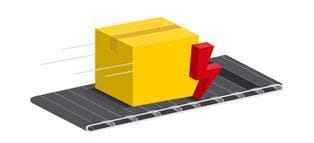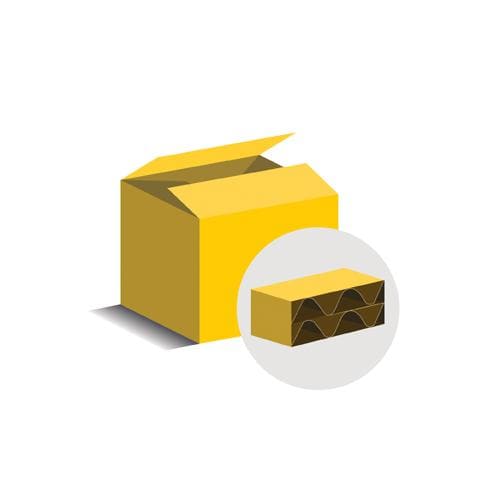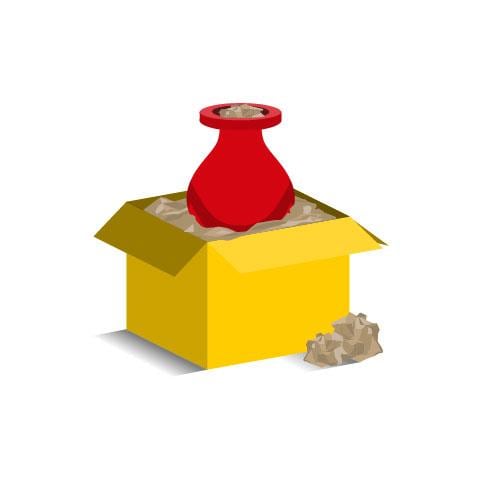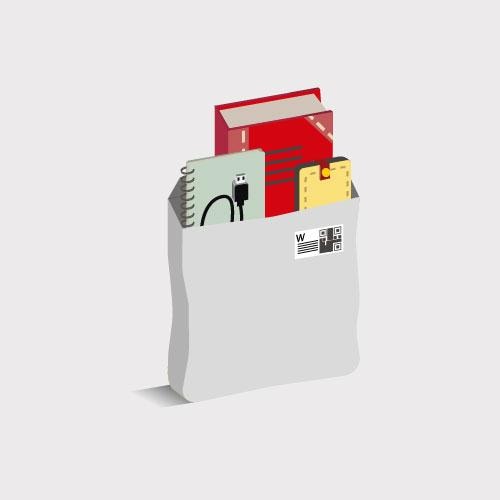When selecting your packaging, please refer to our guidelines for shipping bulky goods to ensure your items are not subject to additional manual processing charges for non-machinable items.
To ensure that every parcel arrives on time and in great shape, we rely on the fast and reliable processing of our highly automated parcel network. For shippers, that means sturdy packaging is essential for protecting parcel contents. This page provides a range of tips and information on how to best package your items and illustrates to you by means of examples the background why good packaging is so important.

In exceptional cases it can come to transport bruises and strains of parcel shipping
- Items stacked on top of one another in vehicles and swap bodies: Heavier items may be placed atop lighter items
- External impacts: Parcels weighing up to 31.5 kg may impact light items
- Weather conditions (heat and cold): During the loading of swap bodies, parcels may be exposed for several hours to temperatures ranging from -10 to +60 oC

Possible impacts of unsuitable packaging
- Transit time delays for damaged items since they have to be re-processed
- Bad first impressions made on customers and higher return rates due to damaged shipments
- Liability for damaged operating equipment (e.g., conveyors) or third-party shipments
PACKING IT RIGHT: TIPS AND INFORMATION FOR BEST RESULTS
Generally speaking, the shipment contents and the transport route determine what packaging you need.
As a result, delicate or sensitive items (e.g., liquids or fragile goods) or international items must be packaged with particular care. Special packaging restrictions (as per European Agreement concerning the International Carriage of Dangerous Goods by Road (ADR)) apply to hazardous goods in limited quantities.
Selecting the right packaging for your shipment involves more than just considering the contents. You also need to consider the following:

| Use sturdy boxes made of corrugated cardboard, and be sure to pick the right category, inspection stamp and quality seal | |
|
Use double-wall (e.g., 2.30 mm quality) external packaging for fragile, heavy or large-volume contents |
|
| Select a box size big enough to hold adequate padding but small enough to keep contents from shifting | |
| Mark parcels 20 kg or heavier as “Schweres Paket” (heavy parcel) either on the label or with a separate sticker | |
| Do not use sales or warehouse packaging | |
| Do not use folding boxes with slits, slots, handholds or handles | |
| Do not use old or used packaging |
Larger, heavier and more fragile contents require higher-quality external pakaging.

| Put protective filler on all sides of the contents and completely fill in all empty spaces including under the lid to prevent dented/staved packaging | |
|
Use suitable filler material:
|
|
| Place heavy items on the bottom, light on the top and fragile in the middle | |
| Do not let the contents come into direct contact with the external packaging or with each other | |
| Do not let any part of the contents protrude from the package |
The heavier and more fragile the contents are, the more protective padding they need.

| Use plastic tape or reinforced paper packaging tape | |
|
Use heavy-duty tear-resistant tape that has high adhesive strength and is at least 50 mm wide |
|
| Apply adhesive tape over the box edges | |
| Use reinforced tape/seals for heavy items | |
| Do not secure with loose strapping | |
| Don't let wires or banding/tape stick out or hang over |
Heavier items require sturdier seas. Rule of thumb: The heavier, the sturdier!
Find here an overview of the most important packaging tips

THINGS TO REMEMBER WHEN USING POLY MAILER BAGS OR PLASTIC ENVELOPES AND FLYER BAGS
- The surrounding edges height must at least also here (analog to the parcel) be at least 1 cm thick all around
- Pay attention that the basic form must be rectangular with minimum dimensions of 15 x 11 x 1 cm
- Glue the flap closure folded down and sealed tightly
- Avoid that smaller goods are protruded in any way
- Recommendation: bags or poly mailers used to ship clothing should be reinforced (e.g., corrugated cardboard sheets)
- Avoid packaging with handholds or carry handles as it cannot be processed by our machines
Please also note the detailed information factsheet about shipping with foil pouches: dhl.de/plasticpouches
You can find details on DHL-approved poly-bags here: dhl.de/approvedpolybag
IMPORTANT LEGAL INFORMATION
According to the General Terms and Conditions and dispatch conditions of DHL Paket, shipments must be packaged in such a way that they provide adequate protection against damage and loss and cause no damage to Deutsche Post or third parties.

)
)